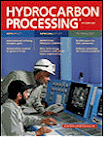Earlier post "Compression Prediction - Compressor Vendor, GPSA & HYSYS" has presented equation in determining Polytropic head, polytropic exponent, gas horse power and compressor discharge temperature.
Recommended :
Subscribes to FREE Hydrocarbon Processing

From data presented, two main findings are (i) GPSA method may be used but shall keep in mind GPSA potentially overpredicted discharge temperature. This potential results over conservative design and excessive cooling required. (ii) HYSYS prediction is using rigorous method which adjusting prediction rigorously and within a good range of prediction. This post will look at the influence of compressibility (z) on predicted temperature difference for several ordinary components.
Recommended :
Subscribes to FREE Hydrocarbon Processing
From data presented, two main findings are (i) GPSA method may be used but shall keep in mind GPSA potentially overpredicted discharge temperature. This potential results over conservative design and excessive cooling required. (ii) HYSYS prediction is using rigorous method which adjusting prediction rigorously and within a good range of prediction. This post will look at the influence of compressibility (z) on predicted temperature difference for several ordinary components.
Check Case Basis
Following tabulating the basis of compression calculation using GPSA and HYSYS.
1) Component used : Methane (C1), Ethane (C2), Propane (C3) and Iso-Butane (i-C4)
2) Suction temperature fixed at 45 degC for all calculation
3) Suction pressure range : 1, 3, 4.5, 5, 10, 20, 50 barg
4a) Discharge pressure for Methane (C1) case : 4, 8, 15, 30, 55 & 150 barg
4b) Discharge pressure for Ethane (C2) case : 4, 8, 15, 30, 55 & 150 barg
4c) Discharge pressure for Propane (C3) case : 4, 8, 15 & 30 barg
4d) Discharge pressure for Is-Butane (I-C4) case : 4, 8 & 15 barg
5) Polytorpic efficiency artificial set at 73% for all cases
5) Polytorpic efficiency artificial set at 73% for all cases
Results
Calculation results shows that
i) GPSA predicted discharge temperature (Td) consistently higher than HYSYS rigorous prediction.
ii) As discharge pressure (Pd) increase, discharge compressibility (Zd) decrease consistently.
iii) As compressibility decrease (Zd) , the discharge temperature difference / gap (dT) increase significantly. See following chart.
iv) Considering discharge temperature difference / gap (dT) of 10 degC as limit, the compressibility is limited to 0.90 for discharge pressure 8 barg (and below).
v) Considering discharge temperature difference / gap (dT) of 10 degC as limit, the compressibility is limited to 0.96 for discharge pressure 15 barg (and below).
v) As discharge pressure increase above 15 barg, discharge temperature difference / gap (dT) will possibly higher than of 10 degC limit.
ii) Once pressure higher than 15 barg, GPSA can severely overpredicts discharge temperature. Shall consider to use rigorous compression calculation (like HYSYS).
Related Topic
v) Considering discharge temperature difference / gap (dT) of 10 degC as limit, the compressibility is limited to 0.96 for discharge pressure 15 barg (and below).
v) As discharge pressure increase above 15 barg, discharge temperature difference / gap (dT) will possibly higher than of 10 degC limit.
Highlights
i) Pressure lower than 15 barg, the GPSA and HYSYS prediction are considered acceptable.ii) Once pressure higher than 15 barg, GPSA can severely overpredicts discharge temperature. Shall consider to use rigorous compression calculation (like HYSYS).
Related Topic
- Compression Prediction - Compressor Vendor, GPSA & HYSYS
- Adjusted Method For Compressor Settle Out (with Vapor & Liquid) Using HYSYS
- Simple Method For Compressor Settle Out Using HYSYS
- Simple Manual Method for Settle Out Condition Estimation
- Combine Anti-surge control (ASC) & Capacity Control (CC) Functions ?

No comments:
Post a Comment